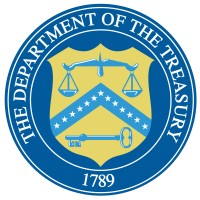
U.S. Department of the Treasury
The Treasury Department is the executive agency responsible for promoting economic prosperity and ensuring the financial security of the United States. The Department is responsible for a wide range of activities such as advising the President on economic and financial issues, encouraging sustainable economic growth, and fostering improved governance in financial institutions. The Department of the Treasury operates and maintains systems that are critical to the nation's financial infrastructure, such as the production of coin and currency, the disbursement of payments to the American public, revenue collection, and the borrowing of funds necessary to run the federal government. The Department works with other federal agencies, foreign governments, and international financial institutions to encourage global economic growth, raise standards of living, and to the extent possible, predict and prevent economic and financial crises. The Treasury Department also performs a critical and far-reaching role in enhancing national security by implementing economic sanctions against foreign threats to the U.S., identifying and targeting the financial support networks of national security threats, and improving the safeguards of our financial systems.






